The Power of Data-Driven Decision Making
Data-driven decision making is the backbone of successful businesses in today’s fast-paced, competitive market. By leveraging data and analytics, companies can gain a deeper understanding of their customers, identify opportunities for growth, and make informed decisions that drive results. In the context of growth hacking, data-driven decision making is crucial for identifying and exploiting opportunities for growth. By analyzing customer behavior, tracking market trends, and monitoring competitor activity, businesses can uncover hidden patterns and insights that inform their growth hacking strategies.
One of the key benefits of data-driven decision making is its ability to reduce the risk of relying on intuition or anecdotal evidence. By using data to inform decisions, businesses can avoid costly mistakes and ensure that their growth hacking efforts are targeted and effective. Additionally, data-driven decision making enables businesses to measure the success of their growth hacking campaigns and make adjustments in real-time.
For example, a company may use data analytics to identify a correlation between customer engagement and social media activity. Armed with this insight, the company can develop a growth hacking strategy that focuses on increasing social media engagement, such as through targeted advertising or influencer partnerships. By tracking the results of this campaign and adjusting their strategy accordingly, the company can optimize its growth hacking efforts and achieve greater success.
Furthermore, data-driven decision making enables businesses to stay ahead of the competition by identifying emerging trends and opportunities. By analyzing market data and customer behavior, businesses can anticipate changes in the market and develop growth hacking strategies that capitalize on these trends. This proactive approach to growth hacking enables businesses to stay ahead of the curve and achieve long-term success.
In conclusion, data-driven decision making is a critical component of successful growth hacking. By leveraging data and analytics, businesses can gain a deeper understanding of their customers, identify opportunities for growth, and make informed decisions that drive results. As the business landscape continues to evolve, the importance of data-driven decision making will only continue to grow, making it an essential skill for any business looking to achieve long-term success.
What is Growth Hacking and How Does it Relate to Data?
Growth hacking is a marketing approach that focuses on using data and analytics to drive rapid growth and experimentation. It involves using data to identify and exploit opportunities for growth, and to measure the success of marketing efforts. Growth hacking is closely related to data-driven strategies, as it relies on the use of data to inform decision-making and to drive growth.
In the context of data-driven growth hacking, data is used to identify opportunities for growth, such as untapped markets or unmet customer needs. Data is also used to measure the success of marketing efforts, and to identify areas for improvement. By using data to drive decision-making, businesses can optimize their marketing efforts and achieve rapid growth.
One of the key benefits of growth hacking is its ability to drive rapid experimentation and iteration. By using data to inform decision-making, businesses can quickly test and refine their marketing efforts, and identify what works and what doesn’t. This approach enables businesses to stay ahead of the competition and to achieve rapid growth.
Examples of successful growth hacking campaigns include Airbnb’s use of data to optimize its pricing and inventory management, and Uber’s use of data to optimize its routing and logistics. In both cases, data was used to drive decision-making and to optimize marketing efforts, resulting in rapid growth and success.
Another example of successful growth hacking is the use of A/B testing to optimize marketing efforts. By using data to test different marketing approaches and to measure their effectiveness, businesses can identify what works and what doesn’t, and optimize their marketing efforts accordingly. This approach enables businesses to achieve rapid growth and to stay ahead of the competition.
In summary, growth hacking is a marketing approach that relies on the use of data to drive rapid growth and experimentation. By using data to inform decision-making and to measure the success of marketing efforts, businesses can optimize their marketing efforts and achieve rapid growth. The use of data-driven growth hacking strategies can help businesses to stay ahead of the competition and to achieve long-term success.
Key Metrics for Data-Driven Growth Hacking
When it comes to data-driven growth hacking, there are several key metrics that businesses need to track in order to measure success and inform their growth hacking strategies. These metrics include customer acquisition costs, retention rates, and lifetime value.
Customer acquisition costs (CAC) refer to the cost of acquiring a new customer, including the cost of marketing, sales, and other expenses. By tracking CAC, businesses can determine the effectiveness of their marketing efforts and identify areas for improvement. For example, if a business is spending $100 to acquire a new customer, but the customer is only generating $50 in revenue, then the business may need to adjust its marketing strategy to reduce CAC.
Retention rates refer to the percentage of customers who continue to do business with a company over time. By tracking retention rates, businesses can determine the effectiveness of their customer service and support efforts, and identify areas for improvement. For example, if a business has a retention rate of 50%, then it may need to improve its customer service and support efforts in order to retain more customers.
Lifetime value (LTV) refers to the total value of a customer to a business over their lifetime. By tracking LTV, businesses can determine the effectiveness of their marketing efforts and identify areas for improvement. For example, if a business has a high LTV, then it may be able to invest more in marketing and customer acquisition efforts in order to attract more customers.
Other key metrics for data-driven growth hacking include conversion rates, click-through rates, and return on investment (ROI). By tracking these metrics, businesses can determine the effectiveness of their marketing efforts and identify areas for improvement.
For example, a business may use data to track the conversion rate of its website, and identify areas for improvement. By optimizing the website and improving the conversion rate, the business can increase revenue and achieve its growth hacking goals.
In addition to tracking key metrics, businesses also need to use data analytics tools to inform their growth hacking strategies. These tools can help businesses to track key metrics, identify trends, and make data-driven decisions. Some popular data analytics tools for growth hacking include Google Analytics, Mixpanel, and HubSpot.
By using data analytics tools and tracking key metrics, businesses can create a comprehensive data-driven growth hacking strategy that drives revenue and achieves growth hacking goals.
How to Use Data to Identify Growth Opportunities
To identify growth opportunities using data, businesses must be able to collect, analyze, and interpret large amounts of information. This involves tracking key metrics, analyzing customer behavior, and monitoring market trends. By doing so, businesses can gain valuable insights into areas such as customer acquisition, retention, and lifetime value.
One effective way to use data to identify growth opportunities is to analyze customer behavior. This can be done by tracking metrics such as website traffic, social media engagement, and customer feedback. By analyzing these metrics, businesses can identify patterns and trends that can inform growth hacking strategies. For example, if a business notices that a particular social media channel is driving a high volume of website traffic, it may choose to focus its marketing efforts on that channel.
Another way to use data to identify growth opportunities is to track market trends. This can be done by monitoring industry reports, competitor activity, and market research. By staying up-to-date on the latest market trends, businesses can identify areas of opportunity and adjust their growth hacking strategies accordingly. For example, if a business notices that a particular industry is experiencing rapid growth, it may choose to focus its marketing efforts on that industry.
Additionally, businesses can use data to monitor competitor activity and identify areas of opportunity. This can be done by tracking metrics such as competitor website traffic, social media engagement, and customer reviews. By analyzing these metrics, businesses can identify areas where they can improve and adjust their growth hacking strategies accordingly.
It’s also important to note that data-driven growth hacking is not just about collecting and analyzing data, but also about using that data to inform decision-making. Businesses must be able to interpret the data they collect and use it to make informed decisions about their growth hacking strategies. This involves using data to identify areas of opportunity, track key metrics, and measure the success of growth hacking campaigns.
By using data to identify growth opportunities, businesses can create effective growth hacking strategies that drive real results. Whether it’s analyzing customer behavior, tracking market trends, or monitoring competitor activity, data-driven growth hacking provides businesses with the insights they need to succeed in today’s competitive market.
Leveraging Data Analytics Tools for Growth Hacking
Data analytics tools play a crucial role in data-driven growth hacking, enabling businesses to track key metrics, identify trends, and inform data-driven decisions. These tools provide valuable insights into customer behavior, market trends, and competitor activity, allowing growth hackers to refine their strategies and optimize their efforts.
Some popular data analytics tools used in growth hacking include Google Analytics, Mixpanel, and HubSpot. Google Analytics provides detailed insights into website traffic, engagement, and conversion rates, while Mixpanel offers advanced analytics capabilities for tracking user behavior and retention. HubSpot, on the other hand, provides an all-in-one marketing, sales, and customer service platform that includes analytics tools for tracking key metrics and identifying trends.
When selecting a data analytics tool for growth hacking, it’s essential to consider the specific needs of your business. Look for tools that offer real-time data, customizable dashboards, and advanced analytics capabilities. Additionally, consider the scalability of the tool, as well as its integration with other marketing and sales tools.
By leveraging data analytics tools, growth hackers can gain a deeper understanding of their target audience, identify opportunities for growth, and optimize their marketing and sales efforts. For example, a growth hacker might use Google Analytics to track website traffic and identify top-performing pages, then use that data to inform content marketing strategies and improve conversion rates.
Data analytics tools can also help growth hackers measure the effectiveness of their campaigns and identify areas for improvement. By tracking key metrics such as customer acquisition costs, retention rates, and lifetime value, growth hackers can refine their strategies and optimize their efforts for maximum ROI.
In the context of data-driven growth hacking, data analytics tools are essential for informing data-driven decisions and driving business growth. By leveraging these tools, businesses can gain a competitive edge, drive revenue, and achieve long-term success.
Case Studies: Successful Data-Driven Growth Hacking Campaigns
Several companies have successfully implemented data-driven growth hacking strategies to drive business growth and revenue. Here are a few examples:
Dropbox, a cloud storage company, used data-driven growth hacking to acquire millions of users. The company’s growth hacking team used data analytics tools to track user behavior and identify opportunities for growth. They discovered that users who installed the Dropbox desktop application were more likely to become paying customers. As a result, the team optimized their website and marketing campaigns to promote the desktop application, resulting in a significant increase in conversions.
Airbnb, a peer-to-peer accommodation platform, used data-driven growth hacking to expand its user base. The company’s growth hacking team used data analytics tools to track user behavior and identify opportunities for growth. They discovered that users who booked accommodations through the platform were more likely to become repeat customers if they received personalized recommendations. As a result, the team developed a personalized recommendation engine that suggested accommodations based on users’ search history and preferences. This resulted in a significant increase in repeat business and revenue.
HubSpot, a marketing and sales software company, used data-driven growth hacking to drive lead generation and conversion. The company’s growth hacking team used data analytics tools to track user behavior and identify opportunities for growth. They discovered that users who downloaded the company’s e-books and whitepapers were more likely to become paying customers. As a result, the team optimized their website and marketing campaigns to promote the e-books and whitepapers, resulting in a significant increase in lead generation and conversion.
These case studies demonstrate the power of data-driven growth hacking in driving business growth and revenue. By using data analytics tools to track user behavior and identify opportunities for growth, companies can develop targeted marketing campaigns and optimize their websites to drive conversions and revenue.
Data-driven growth hacking is a key component of any successful marketing strategy. By leveraging data analytics tools and techniques, companies can gain a deeper understanding of their target audience, identify opportunities for growth, and optimize their marketing efforts to drive business growth and revenue.
Common Mistakes to Avoid in Data-Driven Growth Hacking
While data-driven growth hacking can be a powerful tool for driving business success, there are several common mistakes that businesses make when attempting to implement these strategies. By being aware of these mistakes, businesses can avoid common pitfalls and ensure that their data-driven growth hacking efforts are effective.
One of the most significant mistakes businesses make is relying too heavily on intuition rather than data-driven insights. While intuition can be a valuable tool, it is no substitute for hard data. By ignoring data-driven insights, businesses risk making decisions that are not supported by evidence, which can lead to poor outcomes.
Another common mistake is failing to track key metrics. Without tracking key metrics such as customer acquisition costs, retention rates, and lifetime value, businesses are unable to measure the effectiveness of their growth hacking strategies. This makes it impossible to identify areas for improvement and optimize resources for maximum impact.
Additionally, businesses often make the mistake of not segmenting their data. By failing to segment data, businesses are unable to identify specific trends and patterns that can inform growth hacking strategies. For example, segmenting data by customer demographics or behavior can help businesses identify high-value customer segments and tailor their marketing efforts accordingly.
Furthermore, businesses often make the mistake of not using data to inform their growth hacking strategies. By ignoring data-driven insights, businesses risk implementing strategies that are not optimized for maximum impact. For example, using data to identify the most effective marketing channels can help businesses allocate their resources more effectively and drive better returns on investment.
Finally, businesses often make the mistake of not continuously monitoring and optimizing their growth hacking strategies. By failing to continuously monitor and optimize their strategies, businesses risk missing opportunities for growth and improvement. By regularly reviewing key metrics and adjusting strategies accordingly, businesses can ensure that their data-driven growth hacking efforts are always optimized for maximum impact.
By avoiding these common mistakes, businesses can ensure that their data-driven growth hacking efforts are effective and drive real results. By leveraging data-driven insights to inform growth hacking strategies, businesses can identify opportunities for growth, optimize resources, and drive long-term success.
Putting it all Together: Creating a Data-Driven Growth Hacking Strategy
Creating a successful data-driven growth hacking strategy requires a combination of the right tools, techniques, and mindset. By incorporating the principles and techniques discussed throughout this article, businesses can unlock the full potential of data-driven growth hacking and drive long-term success.
To get started, businesses should begin by identifying their key metrics and tracking them using data analytics tools. This will provide a solid foundation for making data-driven decisions and measuring the effectiveness of growth hacking strategies. Next, businesses should use data to identify growth opportunities, such as analyzing customer behavior, tracking market trends, and monitoring competitor activity.
Once growth opportunities have been identified, businesses can use data-driven insights to inform their growth hacking strategies. This may involve using A/B testing to optimize marketing campaigns, leveraging user feedback to improve product development, or using predictive analytics to identify high-value customer segments.
It’s also essential to avoid common mistakes that can derail data-driven growth hacking efforts. This includes relying too heavily on intuition, failing to track key metrics, and not continuously monitoring and optimizing growth hacking strategies.
By incorporating data-driven growth hacking into their overall business strategy, businesses can drive long-term success and stay ahead of the competition. By leveraging the power of data to inform decision-making, businesses can identify opportunities for growth, optimize resources, and measure success.
Some key takeaways to keep in mind when creating a data-driven growth hacking strategy include:
- Use data to inform decision-making and drive growth
- Track key metrics and use data analytics tools to measure success
- Identify growth opportunities using data-driven insights
- Avoid common mistakes that can derail data-driven growth hacking efforts
- Continuously monitor and optimize growth hacking strategies
By following these key takeaways and incorporating the principles and techniques discussed throughout this article, businesses can create a comprehensive data-driven growth hacking strategy that drives long-term success.






